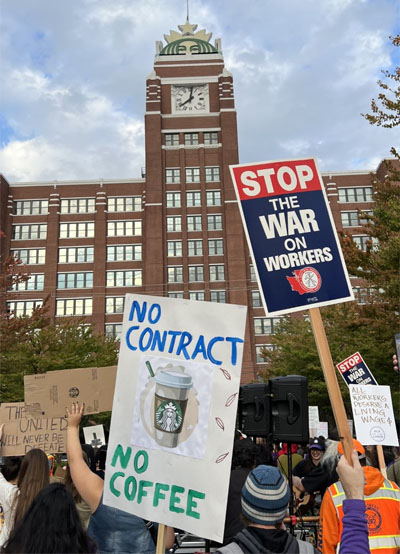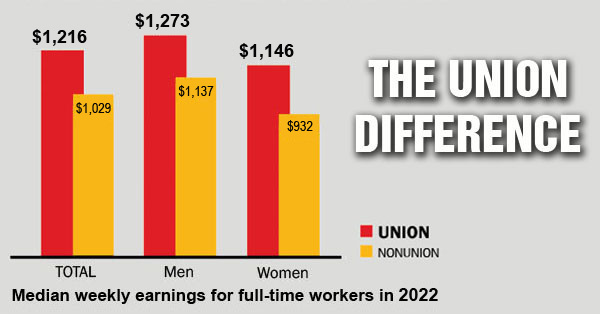LOCAL
Washington remains the 3rd most unionized state
Slight drop in state’s union membership last year doesn’t yet reflect historic wave of organizing, says WSLC
WASHINGTON, D.C. (Jan. 19, 2023) — Union membership in Washington state declined slightly in 2022, but the state remains the third most unionized in the country, according to the annual estimates released today by the federal Bureau of Labor Statistics (BLS).
According to the latest BLS report, Washington had 615,000 union members in 2022, representing 18 percent of the state’s workforce. Only New York and Hawaii had a higher percentage of union members in their workforces than Washington state. For 2021, the BLS estimated Washington had 629,000 union members and 19 percent union density.

April Sims, President of the Washington State Labor Council, AFL-CIO, said the latest BLS numbers don’t yet reflect the wave of union organizing that’s been happening amid the pandemic.
 “As working people have reassessed their jobs and lives during the pandemic, unions have become more popular than ever,” Sims said. “There’s no question that more and more working people are organizing, but these latest statistics don’t reflect that because many of them have yet to get their first union contract or are still fighting in court for union recognition.”
“As working people have reassessed their jobs and lives during the pandemic, unions have become more popular than ever,” Sims said. “There’s no question that more and more working people are organizing, but these latest statistics don’t reflect that because many of them have yet to get their first union contract or are still fighting in court for union recognition.”
A report released by the National Labor Relations Board (NLRB) in October of last year found that in fiscal year 2022, union election petitions increased by 53 percent from the previous year. According to a 2022 Gallup poll, union approval is at its highest level in nearly 60 years, with 71% of Americans supporting labor unions, and studies show that 70% of hourly workers say they would join a union if given the opportunity.
Sims says that what’s holding workers back are weak labor laws and illegal efforts by big corporations to intimidate, harass and fire workers who seek to join together in unions.

Union supporters protest outside Starbucks headquarters in Seattle on Sept. 13, 2022.
“Washington’s own Starbucks and Amazon have become notorious examples of companies that repeatedly break the law and interfere in union organizing,” she said. “Their illegal actions and their refusal to negotiate a contract will not stop their employees from demanding better wages and safer workplaces. At some point our lawmakers must restore the freedom to unionize. But until then, we will continue to fight for better wages and conditions for all of Washington’s working families.”
The NLRB has found both Starbucks and Amazon guilty of illegally firing union supporters and breaking other labor laws in their efforts to quash union organizing. Although in some cases, workers at these companies voted more than a year ago to unionize, neither company has bargained a first union contract with their employees.
Nationally, the new BLS report found that union membership grew by 273,000 members in 2022, spurred in large part by workers of color. The AFL-CIO also said that the data has yet to reflect the past year’s organizing efforts and that the union movement is poised for growth.
 The BLS data don’t capture the surge in worker organizing across every sector, from teaching assistants to baristas to museum workers, construction workers, video game developers and many more, reads today’s AFL-CIO news release. With the resurgence of union organizing and unprecedented federal investment in job creation, the labor movement is poised to grow significantly in the coming years.
The BLS data don’t capture the surge in worker organizing across every sector, from teaching assistants to baristas to museum workers, construction workers, video game developers and many more, reads today’s AFL-CIO news release. With the resurgence of union organizing and unprecedented federal investment in job creation, the labor movement is poised to grow significantly in the coming years.
“In 2022, we saw working people rising up despite often illegal opposition from companies that would rather pay union-busting firms millions than give workers a seat at the table,” said AFL-CIO President Liz Shuler. “The momentum of the moment we are in is clear. Organizing victories are happening in every industry, public and private, and every sector of our economy all across the country. The wave of organizing will continue to gather steam in 2023 and beyond despite broken labor laws that rig the system against workers.”
Union membership once again meant higher wages in 2022. Median weekly earnings for union members was $1,216 last year, according to the BLS report, compared to $1,029 per week for non-union workers. In other words, union members earned more than 18 percent higher wages. That’s the Union Difference.
JOIN TOGETHER! — If you don’t have a union at your job, learn how to join together with your co-workers and get higher wages, better benefits and respect on the job. Click here to get started.






